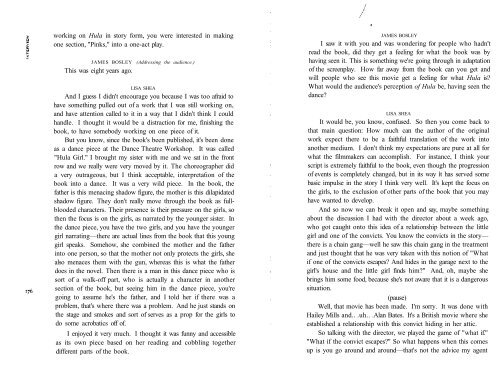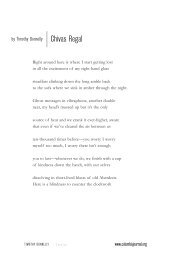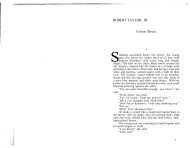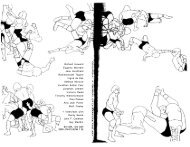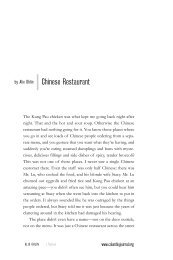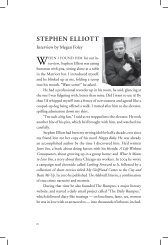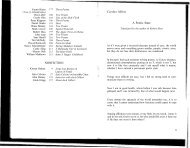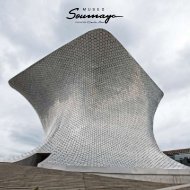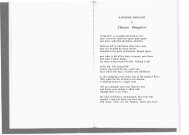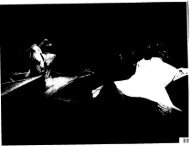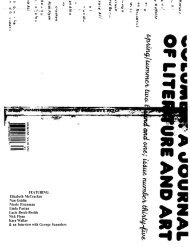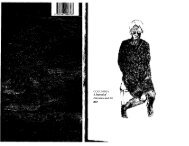Issue 27 - Columbia: A Journal of Literature and Art
Issue 27 - Columbia: A Journal of Literature and Art
Issue 27 - Columbia: A Journal of Literature and Art
You also want an ePaper? Increase the reach of your titles
YUMPU automatically turns print PDFs into web optimized ePapers that Google loves.
working on Hula in story form, you were interested in making<br />
one section, "Pinks," into a one-act play.<br />
JAMES BOSLEY (Addressing the audience.)<br />
This was eight years ago.<br />
LISA SHEA<br />
And I guess I didn't encourage you because I was too afraid to<br />
have something pulled out <strong>of</strong> a work that I was still working on,<br />
<strong>and</strong> have attention called to it in a way that I didn't think I could<br />
h<strong>and</strong>le. I thought it would be a distraction for me, finishing the<br />
book, to have somebody working on one piece <strong>of</strong> it.<br />
But you know, since the book's been published, it's been done<br />
as a dance piece at the Dance Theatre Workshop. It was called<br />
"Hula Girl." I brought my sister with me <strong>and</strong> we sat in the front<br />
row <strong>and</strong> we really were very moved by it. The choreographer did<br />
a very outrageous, but I think acceptable, interpretation <strong>of</strong> the<br />
book into a dance. It was a very wild piece. In the book, the<br />
father is this menacing shadow figure, the mother is this dilapidated<br />
shadow figure. They don't really move through the book as fullblooded<br />
characters. Their presence is their pressure on the girls, so<br />
then the focus is on the girls, as narrated by the younger sister. In<br />
the dance piece, you have the two girls, <strong>and</strong> you have the younger<br />
girl narrating—there are actual lines from the book that this young<br />
girl speaks. Somehow, she combined the mother <strong>and</strong> the father<br />
into one person, so that the mother not only protects the girls, she<br />
also menaces them with the gun, whereas this is what the father<br />
does in the novel. Then there is a man in this dance piece who is<br />
sort <strong>of</strong> a walk-<strong>of</strong>f part, who is actually a character in another<br />
section <strong>of</strong> the book, but seeing him in the dance piece, you're<br />
going to assume he's the father, <strong>and</strong> I told her if there was a<br />
problem, that's where there was a problem. And he just st<strong>and</strong>s on<br />
the stage <strong>and</strong> smokes <strong>and</strong> sort <strong>of</strong> serves as a prop for the girls to<br />
do some acrobatics <strong>of</strong>f <strong>of</strong>.<br />
I enjoyed it very much. I thought it was funny <strong>and</strong> accessible<br />
as its own piece based on her reading <strong>and</strong> cobbling together<br />
different parts <strong>of</strong> the book.<br />
JAMES BOSLEY<br />
I saw it with you <strong>and</strong> was wondering for people who hadn't<br />
read the book, did they get a feeling for what the book was by<br />
having seen it. This is something we're going through in adaptation<br />
<strong>of</strong> the screenplay. How far away from the book can you get <strong>and</strong><br />
will people who see this movie get a feeling for what Hula is?<br />
What would the audience's perception <strong>of</strong> Hula be, having seen the<br />
dance?<br />
LISA SHEA<br />
It would be, you know, confused. So then you come back to<br />
that main question: How much can the author <strong>of</strong> the original<br />
work expect there to be a faithful translation <strong>of</strong> the work into<br />
another medium. I don't think my expectations are pure at all for<br />
what the filmmakers can accomplish. For instance, I think your<br />
script is extremely faithful to the book, even though the progression<br />
<strong>of</strong> events is completely changed, but in its way it has served some<br />
basic impulse in the story I think very well. It's kept the focus on<br />
the girls, to the exclusion <strong>of</strong> other parts <strong>of</strong> the book that you may<br />
have wanted to develop.<br />
And so now we can break it open <strong>and</strong> say, maybe something<br />
about the discussion I had with the director about a week ago,<br />
who got caught onto this idea <strong>of</strong> a relationship between the little<br />
girl <strong>and</strong> one <strong>of</strong> the convicts. You know the convicts in the story—<br />
there is a chain gang—well he saw this chain gang in the treatment<br />
<strong>and</strong> just thought that he was very taken with this notion <strong>of</strong> "What<br />
if one <strong>of</strong> the convicts escapes? And hides in the garage next to the<br />
girl's house <strong>and</strong> the little girl finds him?" And, oh, maybe she<br />
brings him some food, because she's not aware that it is a dangerous<br />
situation.<br />
(pause)<br />
Well, that movie has been made. I'm sorry. It was done with<br />
Hailey Mills <strong>and</strong>.. .uh.. .Alan Bates. It's a British movie where she<br />
established a relationship with this convict hiding in her attic.<br />
So talking with the director, we played the game <strong>of</strong> "what if."<br />
"What if the convict escapes?" So what happens when this comes<br />
up is you go around <strong>and</strong> around—that's not the advice my agent


